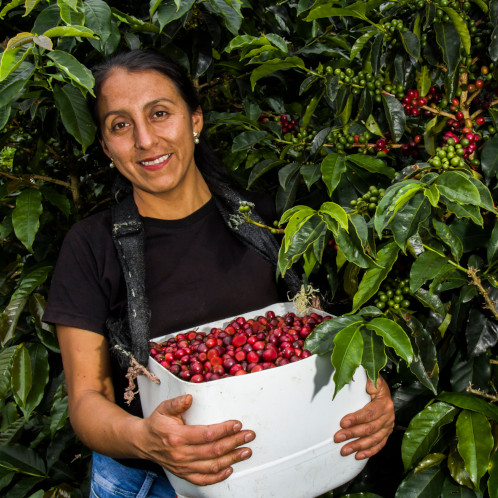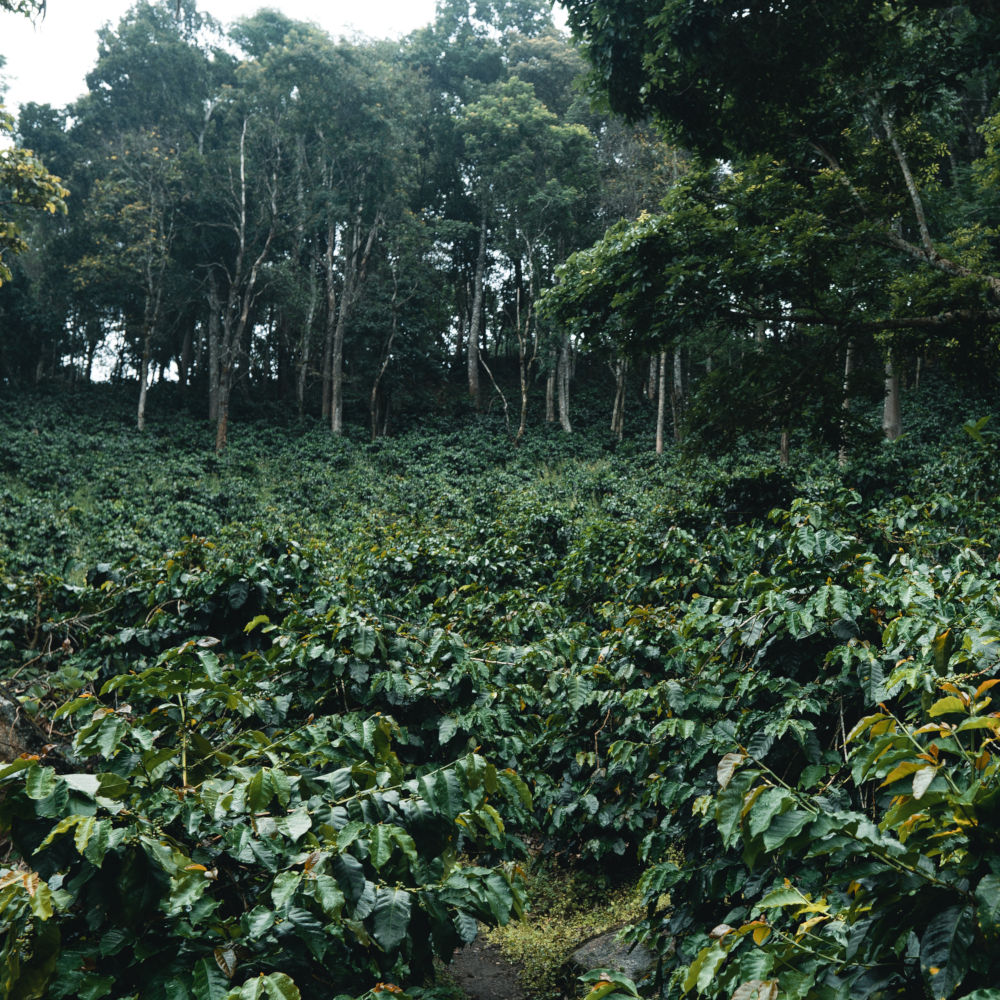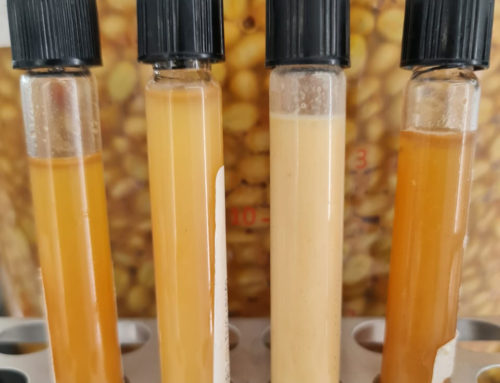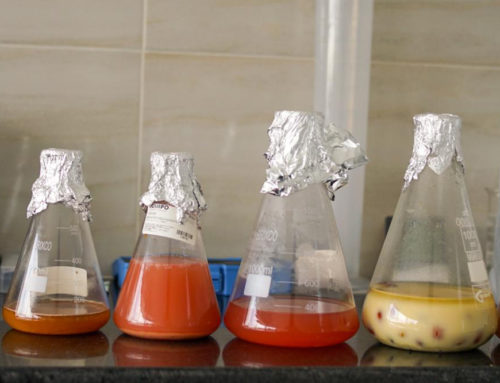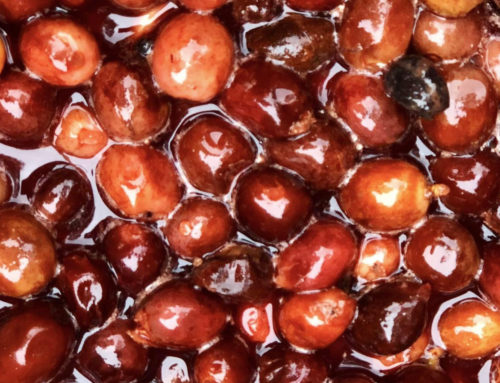Agroforestry and coffee quality
Agroforestry is an agricultural production system where trees and crops grow together on the same plot of land, and the trees fulfill several functions that benefit both the producer and the crop and the ecosystem in general.
Do you want to know more about agroforestry and how it influences the quality of coffee? Then continue reading!
1. Agroforestry was practiced by the first coffee growers.
From 1780 until the end of the 19th century, the first coffee plantations in Central and South America were established within the existing forests.
Instead of cutting down the forests to plant coffee, farmers left the tallest, most valuable trees standing. They only eliminated the excess shrub vegetation—old, diseased trees and timber trees that were used in the construction of houses.
Once the forest was cleared, they planted coffee, banana and fruit plants under the trees. These were mixed plantations, where very little amount of coffee was produced but where farmers could count on many other crops for their own food supply. Any surplus and excess production was sold, providing an additional source of income.
The French businessmen that arrived in the XIX century to cultivate coffee in America were very interested in optimizing the cultivation of coffee. They wanted to increase the production of coffee that was very low in these mixed cultivation systems, and they were the first to print technical manuals on methods to cultivate and process coffee cherries.
In 1822, the French official Alejandro Dumont published a technical booklet for the cultivation of coffee that became very popular among the coffee growers of Central America. He recommended the establishment of fruit trees and banana trees in coffee cultivation lands where there was no shade.
In the majority of cases, this backfired, as the shade proved to be excessive and coffee production remained very low.
Agroforestry system in coffee production. A coffee plantation of shade-grown java in Quindio, Colombia. Credits: Ivan Lopez, Finca La Esperanza.
2. Coffee agroforestry with leguminous species
Around the same time, cocoa farmers already knew that cocoa could only grow well in shaded areas, especially those provided by leguminous trees such as Guamos (Inga species) and Madero negro (Gliricidia sepium).
These species were fast-growing and provided ideal shade with their tall, open canopies.
In addition, they offered wood for firewood and construction, and large amounts of leaf litter that helped control weeds and provide nutrients to the crops.
Soon, the coffee growers observed this and realized that coffee also grew better under the shade of leguminous plants rather than banana and fruit trees. Thus, began the first technical advancements (sometimes referred to as “technification“) of coffee farming in Central America.
Establishing shade for the coffee plants with trees of leguminous species was already implemented in Colombia. However, in these agroforestry systems, the planting density of the coffee plants was very low: only 1,000 coffee plants per hectare.
Although these production systems did not require fertilizers or labor for cultivation, their coffee production was only 50 to 80 arrobas per hectare per year.
3. Technified coffee with free exposure
In the middle of the XX century, the high prices of coffee motivated producers, researchers, and agronomists to believe it was necessary to make a technological change that would allow a greater production of coffee per hectare.
Thus, in the decade of the 50’s, the system of planting technified coffee at high densities (between 5,000 and 10,000 plants per hectare) with free exposure began to spread.
This change in the production model meant going from producing 50 or 60 arrobas of coffee per hectare to producing up to 400 arrobas per hectare in highly technified coffee plantations.
If you want to know more about what this change in the coffee production systems meant, click here.
4. The consequences of the disappearance of Agroforestry in coffee cultivation
The technification of free exposure coffee cultivation led to increased coffee sales and higher income for producers. It also represented a significant increase in the employment of labor for both cultivation and harvesting of coffee beans.
However, it also had negative aspects of which we will only mention a few:
- The disappearance of forests and their consequent ecological impacts on biodiversity and the regulation of water sources.
- The disappearance of diverse productive systems that provided food security to coffee growing families.
- An increase in soil loss through erosion due to weeding using hoes and herbicides.
- A growing dependence on chemical fertilizers in order to sustain the high production of coffee plantations in increasingly degraded soils.
Perhaps the most serious aspect of all is that this model was developed in all coffee growing areas equally. This posed a problem because in many places with unique climate and soil conditions, it was necessary to maintain regulated shade in order to be able to produce high quality coffee.
This is due to the fact that coffee plantations in warm zones, planted in high densities, and in free exposure on poor, sandy and very well drained soils, suffer serious damage in periods of intense and prolonged heat.
Thus, many coffee growers began to have serious problems after a few years of good harvests, especially in years that coincided with El Niño phenomena (drought years), in which the year’s harvests were lost.
Without crops to sell and with high debts from bank loans that were used to buy fertilizers, coffee growers were practically ruined.
Coffee plantations in Minas Gerais, Brazil affected by drought in 2020 and frost in 2021. Source: Camara Peruana del café y cacao, Noticias y Actualidad.
5. Agroforestry as a strategy to adapt to climate change and the energy crisis
Today, concern about climate change is constantly the order of the day. We see daily in the news the devastating effects of an increasingly extreme and unpredictable climate. The severe droughts of 2020 in Brazil followed by frosts that have left thousands of hectares of coffee unproductive are a case in point.
Although the drop in Brazilian coffee production meant an unprecedented rebound in the price of coffee during 2021, it also spelled doom for many Brazilian coffee growers, who were in complete ruin.
It would take more than 2 years for them to return to the coffee production levels they previously were at in 2019. Many of them have already opted to abandon coffee cultivation or diversify it with other products such as soybeans.
6. The return of Agroforestry in coffee cultivation.
Situations similar to those of Brazil in 2020 and 2021 and in Central American countries during 2019 and 2020, have been predicted to occur again.
For more than a decade, there has been talk of the need to implement climate change adaptation practices in coffee cultivation, and the implementation of regulated shade is one of the most important aspects.
The only way in which we can make coffee plantations more stable and tolerant to extreme climatic events is to return to agroforestry.
In agroforestry systems, the tree component creates a microclimate within the plantation. Temperature, humidity, and soil moisture retention are better regulated. In the winter, the trees function as a barrier that protects the coffee plants from winds, heavy rain and hail.
The return to agroforestry systems, planting trees into coffee fields, is one of the most important ways to make coffee plantations more resilient and tolerant to extreme climatic events. Browse here expert producers implementing agroforestry in coffee production that result in excellent coffees.
7. The Benefits of Organic Matter from Tree Litter
Trees, especially leguminous trees, produce large quantities of leaf litter that is converted into organic matter when it falls to the ground.
Soil organic matter can retain 10 times its weight in water. Therefore, in agroforestry systems, the organic matter content of the soil increases and thus there is a greater amount of water available in the soil.
For this reason, coffee plants that grow under shade can better resist prolonged summer periods, reducing the risk of losing the entire harvest.
Also, it should not be forgotten that leguminous species fix atmospheric nitrogen in the soil. Having a regulated shade of leguminous trees in the coffee crop can save up to 30% in the use of synthetic nitrogen fertilizers.
This is an important fact to take into account now that we are suffering the consequences of an energy crisis due to gas shortages, which has meant the closure of several urea production plants in the world and an increase in the price of fertilizers, tripling so far this year (2022).
8. Agroforestry and the physical quality of coffee
In times of El Niño, there will always be a reduction in the quantity and quality of coffee produced, even in shaded coffee plantations.
However, the percentage of physical defects in coffee such as the percentage of pasillas, shriveled coffee, coffee beans, and damaged coffee beans will be much lower compared to coffee plantations that grow under full sun exposure.
The same occurs with defects such as cherries damaged by hail, in which the percentage is lower in coffee plantations grown under shade.
Several studies have shown that coffee beans from plants grown under shade have greater size and weight, and a lower percentage of imperfect beans and pasillas.
9. Agroforestry and Coffee Cup Quality
The cup quality of coffee depends on many factors. Believe it or not, shade grown coffee can present better flavor and aroma characteristics than beans produced in free exposure coffee plantations.
If you do not know much about the factors that influence the quality of coffee in the cup, we invite you to read our prior post COFFEE FERMENTATION: 8 THINGS YOU PROBABLY DO NOT KNOW. Now that you know what factors influence the quality of the coffee cup, let’s move on.
How can shade affect the quality of coffee in the cup?
Inside a coffee plantation that grows under shade, a microclimate is created in which there can be differences of 1.5-3 °C less compared to the outside environmental temperature.
Several studies have shown that in coffee plants grown in colder climates or under shade, the ripening time of the cherries is longer. This means that there is more time for more carbohydrates to accumulate in the bean. As more carbohydrates accumulate, the berries become larger, heavier, and have fewer physical defects.
Since the physical quality of the bean is linked to cup quality, these larger and heavier beans will result in cups with more sweetness, acidity, and body.
There is also more time for a greater amount of trigonelline and chlorogenic acid to degrade, which are the compounds responsible for the bitter and astringent taste of the coffee.
There will also be more time for a greater amount of esters, aldehydes, ketones, and alcohols to be produced, which are responsible for the flavor and aroma of coffee.
At the same time, the lengthening of the maturation period gives rise to the degradation of undesirable compounds, and the corresponding greater production of desirable compounds.
This in turn translates into a better flavor and aroma of the coffee cup.
10. Other benefits of agroforestry in coffee cultivation
Finally, we do not want to end this article without mentioning other benefits that agroforestry offers as a sustainable agricultural production system.
- Agroforestry systems harbor a greater amount of native fauna, flora, and microbiota, contributing to the conservation of biodiversity.
- The flowers of coffee and native trees are highly sought after by bees. Thus, agroforestry in coffee crops helps to protect and conserve these little friends that are so threatened today.
- Agroforestry crops do not use chemical pesticides. Therefore, the establishment of natural enemies that control pests and crop diseases is favored.
- Agroforestry systems do not require synthetic fertilizers, thus helping to avoid chemical degradation of soils and contamination of aquifers.
- Trees and the leaf litter they produce help protect the soil from erosion and increase its fertility.
- Trees are important CO2 sinks.
- Trees are indispensable for the regulation of the water cycle. If there are more trees, we will have more water in our rivers and subway aquifers.
References
- Cardona C., D., & Sadeghian, S. (mayo de 2005). Beneficios del sombrío de guamos en suelos cafeteros. (C. FNC, Ed.) Avances Técnicos CENICAFÉ(335). Link: https://www.cenicafe.org/es/publications/avt0335.pdf.
- Farfán V., F., & Mestre M., A. (Diciembre de 2004). MANEJO DEL SOMBRÍO Y FERTILIZACIÓN DEL CAFÉ EN LA ZONA CENTRAL COLOMBIANA. (F. CENICAFÉ, Ed.) Avances Técnicos CENICAFÉ N° 330, 1-8.
- Gómez G., G. (Enero de 1978). Cambio técnico-social y económico de la zona cafetera 1968 -1978. Revista de la Universidad de La Salle, 1(4), 25-46. Link: https://ciencia.lasalle.edu.co/cgi/viewcontent.cgi?article=2044&context=ruls.
- Lara E., L. (2005). EFECTOS DE LA ALTITUD, SOMBRA, PRODUCCION Y FERTILIZACION SOBRE LA CALIDAD DEL CAFÉ (Coffea arabica L. var. Caturra) PRODUCIDO EN SISTEMAS AGROFORESTALES DE LA ZONA CAFETALERA NORCENTRAL DE NICARAGUA. Tesis de Grado, CATIE, Turrialba, Costa Rica.
- Montes, Mirleydis & Ledezma, Astrid & Martínez-Dueñas, William. (2019). Apropiaciones sociales de la ciencia y la tecnología en la caficultura. Jangwa Pana. 18. 183-213. 10.21676/16574923.2925.
- Naranjo G., C. (Octubre- Diciembre de 1999). La primera modernización de la caficultura costarricence (1890-1950). (U. d. Rica, Ed.) Dialogos. Revista electrónica de historia, 1(1), 1-31.
Thank you for taking the time to read this article. We’d love to hear your feedback and opinion on this article. If you have experience related to agroforestry in coffee we hope you will share your results with us. And as always, we invite you to subscribe to our blog so that you can be informed about new articles and updates on the exciting world of coffee.
